Evaluation of the Effect of Sentinel-1 SAR and Environmental Factors in Alfalfa Yield and Quality Estimation
Abstract
1. Introduction
2. Materials and Methods
2.1. Study Area and Ground Data Sampling
2.2. Satellite Image Acquisition and Processing
2.3. Statistical Analysis and Machine Learning Modelling
3. Results and Discussion
3.1. Ground Data Statistics
3.2. Variations in Alfalfa DMY and Quality Traits Explained by Environmental Factors and Image Features
3.3. Performance for Alfalfa DMY and Quality Traits
3.4. Impact of Environmental Factors and SAR Features on Estimates
3.5. Visualization of the Estimated Alfalfa DMY and Quality Traits
4. Conclusions
Author Contributions
Funding
Data Availability Statement
Acknowledgments
Conflicts of Interest
Appendix A
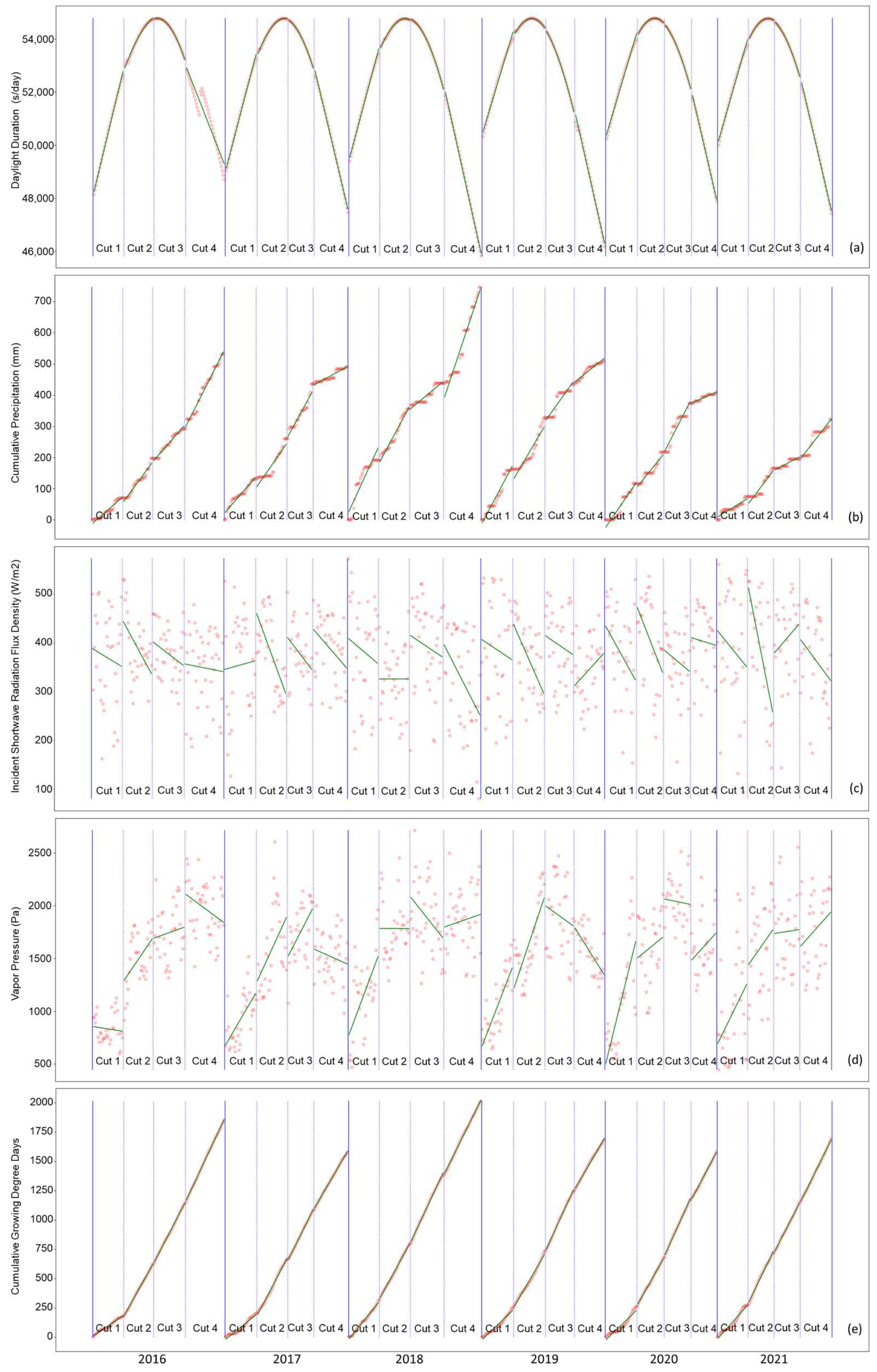
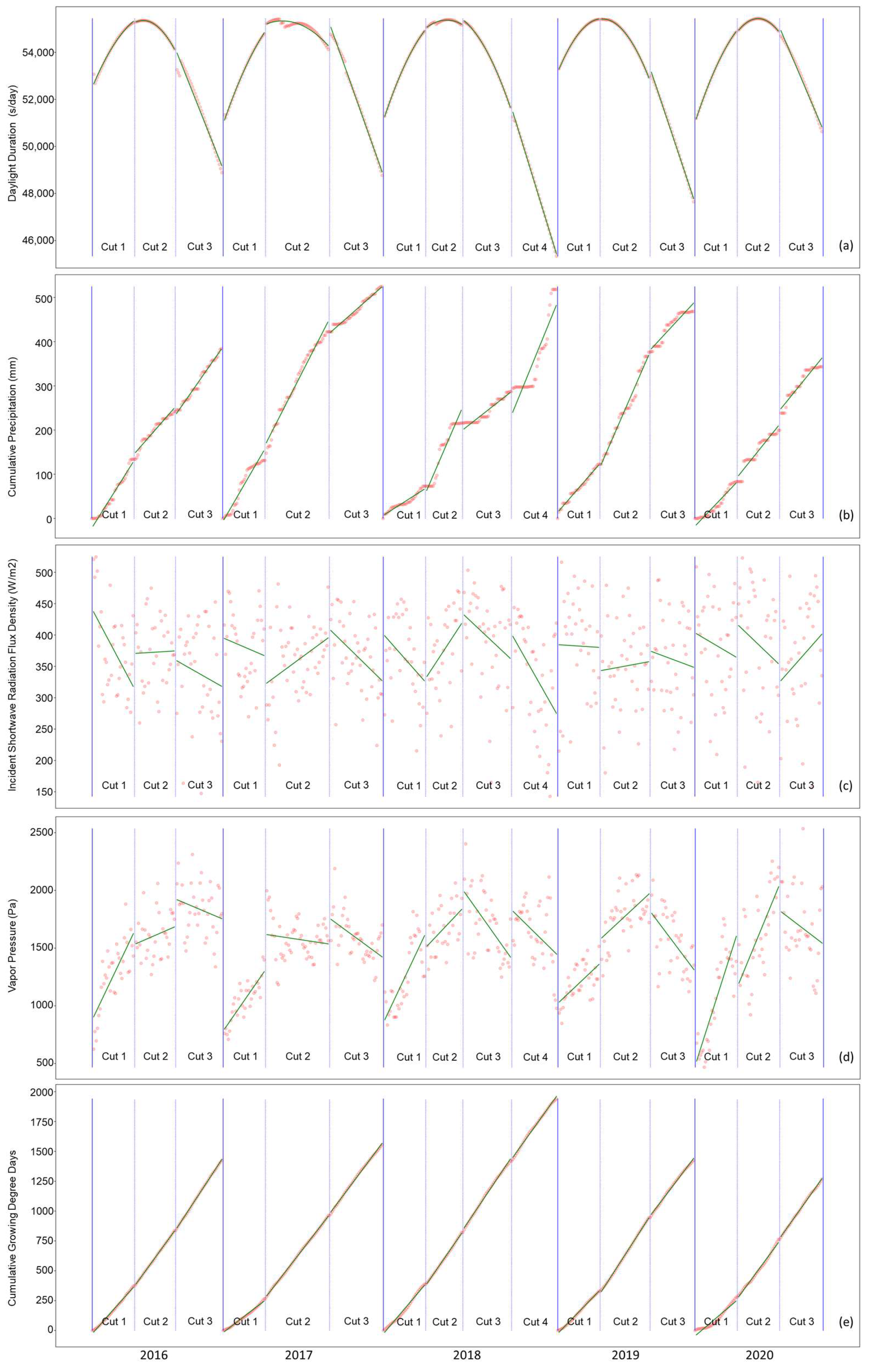
References
- Noland, R.L.; Wells, M.S.; Coulter, J.A.; Tiede, T.; Baker, J.M.; Martinson, K.L.; Sheaffer, C.C. Estimating Alfalfa Yield and Nutritive Value Using Remote Sensing and Air Temperature. Field Crops Res. 2018, 222, 189–196. [Google Scholar] [CrossRef]
- Radovic, J.; Sokolovic, D.; Markovic, J. Alfalfa-Most Important Perennial Forage Legume in Animal Husbandry. Bio. Anim. Husb. 2009, 25, 465–475. [Google Scholar] [CrossRef]
- USDA, National Agricultural Statistics Service. Crop Production 2022 Summary; USDA: Washington, DC, USA, 2023.
- Hancock, D.W.; Collins, M. Forage Preservation Method Influences Alfalfa Nutritive Value and Feeding Characteristics. Crop Sci. 2006, 46, 688–694. [Google Scholar] [CrossRef]
- Kendall, C.; Leonardi, C.; Hoffman, P.C.; Combs, D.K. Intake and Milk Production of Cows Fed Diets That Differed in Dietary Neutral Detergent Fiber and Neutral Detergent Fiber Digestibility. J. Dairy Sci. 2009, 92, 313–323. [Google Scholar] [CrossRef] [PubMed]
- Ruppert, L.D.; Drackley, J.K.; Bremmer, D.R.; Clark, J.H. Effects of Tallow in Diets Based on Corn Silage or Alfalfa Silage on Digestion and Nutrient Use by Lactating Dairy Cows1. J. Dairy Sci. 2003, 86, 593–609. [Google Scholar] [CrossRef] [PubMed]
- Broderick, G.A.; Walgenbach, R.P.; Maignan, S. Production of Lactating Dairy Cows Fed Alfalfa or Red Clover Silage at Equal Dry Matter or Crude Protein Contents in the Diet1. J. Dairy Sci. 2001, 84, 1728–1737. [Google Scholar] [CrossRef] [PubMed]
- Feng, L.; Zhang, Z.; Ma, Y.; Du, Q.; Williams, P.; Drewry, J.; Luck, B. Alfalfa Yield Prediction Using UAV-Based Hyperspectral Imagery and Ensemble Learning. Remote Sens. 2020, 12, 2028. [Google Scholar] [CrossRef]
- Feng, L.; Zhang, Z.; Ma, Y.; Sun, Y.; Du, Q.; Williams, P.; Drewry, J.; Luck, B. Multitask Learning of Alfalfa Nutritive Value From UAV-Based Hyperspectral Images. IEEE Geosci. Remote Sens. Lett. 2022, 19, 5506305. [Google Scholar] [CrossRef]
- Azadbakht, M.; Ashourloo, D.; Aghighi, H.; Homayouni, S.; Shahrabi, H.S.; Matkan, A.; Radiom, S. Alfalfa Yield Estimation Based on Time Series of Landsat 8 and PROBA-V Images: An Investigation of Machine Learning Techniques and Spectral-Temporal Features. Remote Sens. Appl. Soc. Environ. 2022, 25, 100657. [Google Scholar] [CrossRef]
- Kayad, A.G.; Al-Gaadi, K.A.; Tola, E.; Madugundu, R.; Zeyada, A.M.; Kalaitzidis, C. Assessing the Spatial Variability of Alfalfa Yield Using Satellite Imagery and Ground-Based Data. PLoS ONE 2016, 11, e0157166. [Google Scholar] [CrossRef] [PubMed]
- Vong, C.N.; Zhou, J.; Tooley, J.A.; Naumann, H.D.; Lory, J.A. Estimating Forage Dry Matter and Nutritive Value Using UAV- and Ground-Based Sensors–A Preliminary Study. In Proceedings of the 2019 ASABE Annual International Meeting, Boston, MA, USA, 7–10 July 2019; American Society of Agricultural and Biological Engineers: St. Joseph, MI, USA, 2019. [Google Scholar]
- de Castro, A.I.; Shi, Y.; Maja, J.M.; Peña, J.M. UAVs for Vegetation Monitoring: Overview and Recent Scientific Contributions. Remote Sens. 2021, 13, 2139. [Google Scholar] [CrossRef]
- Maimaitijiang, M.; Sagan, V.; Sidike, P.; Daloye, A.M.; Erkbol, H.; Fritschi, F.B. Crop Monitoring Using Satellite/UAV Data Fusion and Machine Learning. Remote Sens. 2020, 12, 1357. [Google Scholar] [CrossRef]
- Dvorak, J.S.; Pampolini, L.F.; Jackson, J.J.; Seyyedhasani, H.; Sama, M.P.; Goff, B. Predicting Quality and Yield of Growing Alfalfa from a UAV. Trans. ASABE 2021, 64, 63–72. [Google Scholar] [CrossRef]
- Chandel, A.K.; Khot, L.R.; Yu, L.-X. Alfalfa (Medicago sativa L.) Crop Vigor and Yield Characterization Using High-Resolution Aerial Multispectral and Thermal Infrared Imaging Technique. Comput. Electron. Agric. 2021, 182, 105999. [Google Scholar] [CrossRef]
- Shakhatreh, H.; Sawalmeh, A.H.; Al-Fuqaha, A.; Dou, Z.; Almaita, E.; Khalil, I.; Othman, N.S.; Khreishah, A.; Guizani, M. Unmanned Aerial Vehicles (UAVs): A Survey on Civil Applications and Key Research Challenges. IEEE Access 2019, 7, 48572–48634. [Google Scholar] [CrossRef]
- Colpaert, A. Satellite and UAV Platforms, Remote Sensing for Geographic Information Systems. Sensors 2022, 22, 4564. [Google Scholar] [CrossRef] [PubMed]
- Bahrami, H.; Homayouni, S.; Safari, A.; Mirzaei, S.; Mahdianpari, M.; Reisi-Gahrouei, O. Deep Learning-Based Estimation of Crop Biophysical Parameters Using Multi-Source and Multi-Temporal Remote Sensing Observations. Agronomy 2021, 11, 1363. [Google Scholar] [CrossRef]
- Ranjbar, S.; Akhoondzadeh, M.; Brisco, B.; Amani, M.; Hosseini, M. Soil Moisture Change Monitoring from C and L-Band SAR Interferometric Phase Observations. IEEE J. Sel. Top. Appl. Earth Obs. Remote Sens. 2021, 14, 7179–7197. [Google Scholar] [CrossRef]
- He, M.; Kimball, J.S.; Maneta, M.P.; Maxwell, B.D.; Moreno, A.; Beguería, S.; Wu, X. Regional Crop Gross Primary Productivity and Yield Estimation Using Fused Landsat-MODIS Data. Remote Sens. 2018, 10, 372. [Google Scholar] [CrossRef]
- Sadenova, M.A.; Beisekenov, N.A.; Apshikur, B.; Khrapov, S.S.; Kapasov, A.K.; Mamysheva, A.M.; Klemeš, J.J. Modelling of Alfalfa Yield Forecasting Based on Earth Remote Sensing (ERS) Data and Remote Sensing Methods. Chem. Eng. Trans. 2022, 94, 697–702. [Google Scholar] [CrossRef]
- He, M.; Hu, Y.; Chen, N.; Wang, D.; Huang, J.; Stamnes, K. High Cloud Coverage over Melted Areas Dominates the Impact of Clouds on the Albedo Feedback in the Arctic. Sci. Rep. 2019, 9, 9529. [Google Scholar] [CrossRef] [PubMed]
- Sarafanov, M.; Kazakov, E.; Nikitin, N.O.; Kalyuzhnaya, A.V. A Machine Learning Approach for Remote Sensing Data Gap-Filling with Open-Source Implementation: An Example Regarding Land Surface Temperature, Surface Albedo and NDVI. Remote Sens. 2020, 12, 3865. [Google Scholar] [CrossRef]
- Ulaby, F.T.; Long, D.G. Microwave Radar and Radiometric Remote Sensing; The University of Michigan Press: Ann Arbor, MI, USA, 2014; ISBN 978-0-472-11935-6. [Google Scholar]
- Potin, P.; Rosich, B.; Grimont, P.; Miranda, N.; Shurmer, I.; O’Connell, A.; Torres, R.; Krassenburg, M. Sentinel-1 Mission Status. In Proceedings of the EUSAR 2016: 11th European Conference on Synthetic Aperture Radar, Hamburg, Germany, 6–9 June 2016; VDE: Berlin, Germany, 2016; pp. 1–6. [Google Scholar]
- Crabbe, R.A.; Lamb, D.W.; Edwards, C.; Andersson, K.; Schneider, D. A Preliminary Investigation of the Potential of Sentinel-1 Radar to Estimate Pasture Biomass in a Grazed Pasture Landscape. Remote Sens. 2019, 11, 872. [Google Scholar] [CrossRef]
- Raab, C.; Riesch, F.; Tonn, B.; Barrett, B.; Meißner, M.; Balkenhol, N.; Isselstein, J. Target-Oriented Habitat and Wildlife Management: Estimating Forage Quantity and Quality of Semi-Natural Grasslands with Sentinel-1 and Sentinel-2 Data. Remote Sens. Ecol. Conserv. 2020, 6, 381–398. [Google Scholar] [CrossRef]
- Bahrami, H.; Homayouni, S.; McNairn, H.; Hosseini, M.; Mahdianpari, M. Regional Crop Characterization Using Multi-Temporal Optical and Synthetic Aperture Radar Earth Observations Data. Can. J. Remote Sens. 2022, 48, 258–277. [Google Scholar] [CrossRef]
- Tedesco, D.; Nieto, L.; Hernández, C.; Rybecky, J.F.; Min, D.; Sharda, A.; Hamilton, K.J.; Ciampitti, I.A. Remote Sensing on Alfalfa as an Approach to Optimize Production Outcomes: A Review of Evidence and Directions for Future Assessments. Remote Sens. 2022, 14, 4940. [Google Scholar] [CrossRef]
- Smeal, D.; Kallsen, C.E.; Sammis, T.W. Alfalfa Yield as Related to Transpiration, Growth Stage and Environment. Irrig. Sci. 1991, 12, 79–86. [Google Scholar] [CrossRef]
- Suwignyo, B.; Suhartanto, B.; Noviandi, C.T.; Umami, N.; Suseno, N.; Hermanto; Prasetiyono, B.W.H.E. Generative Plant Characteristics Alfalfa (Medicago sativa L.) on Different Levels of Dolomite and Lighting Duration. In Proceedings of the 1st International Conference on Tropical Agriculture, Yogyakarta, Indonesia, 25–26 October 2016; Springer: Berlin/Heidelberg, Germany, 2017; pp. 353–361. [Google Scholar]
- Ren, L.; Bennett, J.A.; Coulman, B.; Liu, J.; Biligetu, B. Forage Yield Trend of Alfalfa Cultivars in the Canadian Prairies and Its Relation to Environmental Factors and Harvest Management. Grass Forage Sci. 2021, 76, 390–399. [Google Scholar] [CrossRef]
- Robison, G.D.; Robinson, G.D.; Massengale, M.A. Effect of Night Temperature on Growth and Development of Alfalfa (Medicago sativa L.). J. Ariz. Acad. Sci. 1969, 5, 227–231. [Google Scholar] [CrossRef]
- Gámez, A.L.; Vatter, T.; Santesteban, L.G.; Araus, J.L.; Aranjuelo, I. Onfield Estimation of Quality Parameters in Alfalfa through Hyperspectral Spectrometer Data. Comput. Electron. Agric. 2024, 216, 108463. [Google Scholar] [CrossRef]
- Dellar, M.; Topp, C.F.E.; Banos, G.; Wall, E. A Meta-Analysis on the Effects of Climate Change on the Yield and Quality of European Pastures. Agric. Ecosyst. Environ. 2018, 265, 413–420. [Google Scholar] [CrossRef]
- Andresen, J.A.; Alagarswamy, G.; Rotz, C.A.; Ritchie, J.T.; LeBaron, A.W. Weather Impacts on Maize, Soybean, and Alfalfa Production in the Great Lakes Region, 1895–1996. Agron. J. 2001, 93, 1059–1070. [Google Scholar] [CrossRef]
- Bertram, M.; Cavadini, J. Wisconsin Alfalfa Yield and Persistence (Wayp) Program 2020 Summary Report; University of Wisconsin-Madison: Madison, WI, USA, 2020. [Google Scholar]
- Thornton, M.M.; Shrestha, R.; Wei, Y.; Thornton, P.E.; Kao, S.-C.; Wilson, B.E. Daymet: Daily Surface Weather Data on a 1-Km Grid for North America, Version 4 R1; ORNL DAAC: Oak Ridge, TN, USA, 2022. [Google Scholar]
- Sanderson, M.A.; Karnezos, T.P.; Matches, A.G. Morphological Development of Alfalfa as a Function of Growing Degree Days. J. Prod. Agric. 1994, 7, 239–242. [Google Scholar] [CrossRef]
- Confalonieri, R.; Bechini, L. A Preliminary Evaluation of the Simulation Model CropSyst for Alfalfa. Eur. J. Agron. 2004, 21, 223–237. [Google Scholar] [CrossRef]
- dos Santos, E.P.; Da Silva, D.D.; do Amaral, C.H. Vegetation Cover Monitoring in Tropical Regions Using SAR-C Dual-Polarization Index: Seasonal and Spatial Influences. Int. J. Remote Sens. 2021, 42, 7581–7609. [Google Scholar] [CrossRef]
- Hird, J.N.; DeLancey, E.R.; McDermid, G.J.; Kariyeva, J. Google Earth Engine, Open-Access Satellite Data, and Machine Learning in Support of Large-Area Probabilistic Wetland Mapping. Remote Sens. 2017, 9, 1315. [Google Scholar] [CrossRef]
- Nasirzadehdizaji, R.; Balik Sanli, F.; Abdikan, S.; Cakir, Z.; Sekertekin, A.; Ustuner, M. Sensitivity Analysis of Multi-Temporal Sentinel-1 SAR Parameters to Crop Height and Canopy Coverage. Appl. Sci. 2019, 9, 655. [Google Scholar] [CrossRef]
- Lamb, J.F.S.; Sheaffer, C.C.; Rhodes, L.H.; Sulc, R.M.; Undersander, D.J.; Brummer, E.C. Five Decades of Alfalfa Cultivar Improvement: Impact on Forage Yield, Persistence, and Nutritive Value. Crop Sci. 2006, 46, 902–909. [Google Scholar] [CrossRef]
- Avice, J.C.; Ourry, A.; Lemaire, G.; Volenec, J.J.; Boucaud, J. Root Protein and Vegetative Storage Protein Are Key Organic Nutrients for Alfalfa Shoot Regrowth. Crop Sci. 1997, 37, 1187–1193. [Google Scholar] [CrossRef]
- Hannaway, D.B.; Shuler, P.E. Nitrogen Fertilization in Alfalfa Production. J. Prod. Agric. 1993, 6, 80–85. [Google Scholar] [CrossRef]
- Jungers, J.M.; Kaiser, D.E.; Lamb, J.F.S.; Lamb, J.A.; Noland, R.L.; Samac, D.A.; Wells, M.S.; Sheaffer, C.C. Potassium Fertilization Affects Alfalfa Forage Yield, Nutritive Value, Root Traits, and Persistence. Agron. J. 2019, 111, 2843–2852. [Google Scholar] [CrossRef]
- Laroche, J.-P.; Gervais, R.; Lapierre, H.; Ouellet, D.R.; Tremblay, G.F.; Halde, C.; Boucher, M.-S.; Charbonneau, É. Milk Production and Efficiency of Utilization of Nitrogen, Metabolizable Protein, and Amino Acids Are Affected by Protein and Energy Supplies in Dairy Cows Fed Alfalfa-Based Diets. J. Dairy Sci. 2022, 105, 329–346. [Google Scholar] [CrossRef] [PubMed]
- Bani, P.; Minuti, A.; Luraschi, O.; Ligabue, M.; Ruozzi, F. Genetic and Environmental Influences on in Vitro Digestibility of Alfalfa. Ital. J. Anim. Sci. 2007, 6, 251–253. [Google Scholar] [CrossRef]
- Bhattacharya, A. Dry Matter Production, Partitioning, and Seed Yield Under Soil Water Deficit: A Review. In Soil Water Deficit and Physiological Issues in Plants; Bhattacharya, A., Ed.; Springer: Singapore, 2021; pp. 585–702. ISBN 978-981-336-276-5. [Google Scholar]
- Zhou, H.; Zhou, G.; Song, X.; He, Q. Dynamic Characteristics of Canopy and Vegetation Water Content during an Entire Maize Growing Season in Relation to Spectral-Based Indices. Remote Sens. 2022, 14, 584. [Google Scholar] [CrossRef]
- Baghdadi, N.; El Hajj, M.; Zribi, M.; Bousbih, S. Calibration of the Water Cloud Model at C-Band for Winter Crop Fields and Grasslands. Remote Sens. 2017, 9, 969. [Google Scholar] [CrossRef]
- Mandal, D.; Kumar, V.; Lopez-Sanchez, J.M.; Bhattacharya, A.; McNairn, H.; Rao, Y.S. Crop Biophysical Parameter Retrieval from Sentinel-1 SAR Data with a Multi-Target Inversion of Water Cloud Model. Int. J. Remote Sens. 2020, 41, 5503–5524. [Google Scholar] [CrossRef]
- Graybill, J.S.; Cox, W.J.; Otis, D.J. Yield and Quality of Forage Maize as Influenced by Hybrid, Planting Date, and Plant Density. Agron. J. 1991, 83, 559–564. [Google Scholar] [CrossRef]
- Phipps, R.H.; Weller, R.F. The Development of Plant Components and Their Effects on the Composition of Fresh and Ensiled Forage Maize: 1. The Accumulation of Dry Matter, Chemical Composition and Nutritive Value of Fresh Maize. J. Agric. Sci. 1979, 92, 471–483. [Google Scholar] [CrossRef]
- Sanderson, M.A.; Jones, R.M.; Read, J.C.; Lippke, H. Digestibility and Lignocellulose Composition of Forage Corn Morphological Components. J. Prod. Agric. 1995, 8, 169–174. [Google Scholar] [CrossRef]
- Widdicombe, W.D.; Thelen, K.D. Row Width and Plant Density Effect on Corn Forage Hybrids. Agron. J. 2002, 94, 326–330. [Google Scholar] [CrossRef]
- Chiu, T.; Sarabandi, K. Electromagnetic Scattering from Short Branching Vegetation. IEEE Trans. Geosci. Remote Sens. 2000, 38, 911–925. [Google Scholar] [CrossRef]
- Evans, D.L.; Farr, T.G.; van Zyl, J.J.; Zebker, H.A. Radar Polarimetry: Analysis Tools and Applications. IEEE Trans. Geosci. Remote Sens. 1988, 26, 774–789. [Google Scholar] [CrossRef]
- Patel, P.; Srivastava, H.S.; Panigrahy, S.; Parihar, J.S. Comparative Evaluation of the Sensitivity of Multi-polarized Multi-frequency SAR Backscatter to Plant Density. Int. J. Remote Sens. 2006, 27, 293–305. [Google Scholar] [CrossRef]
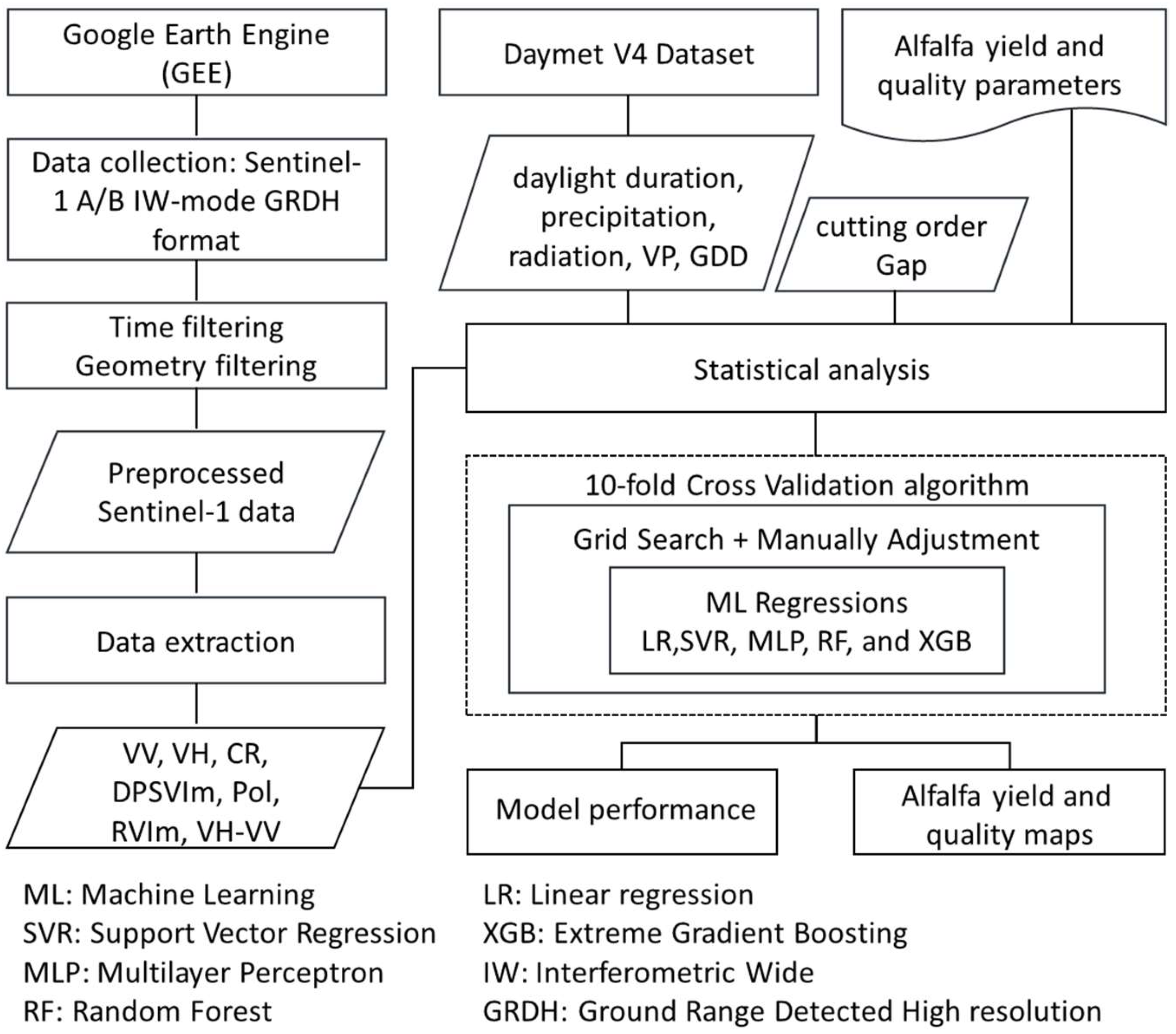
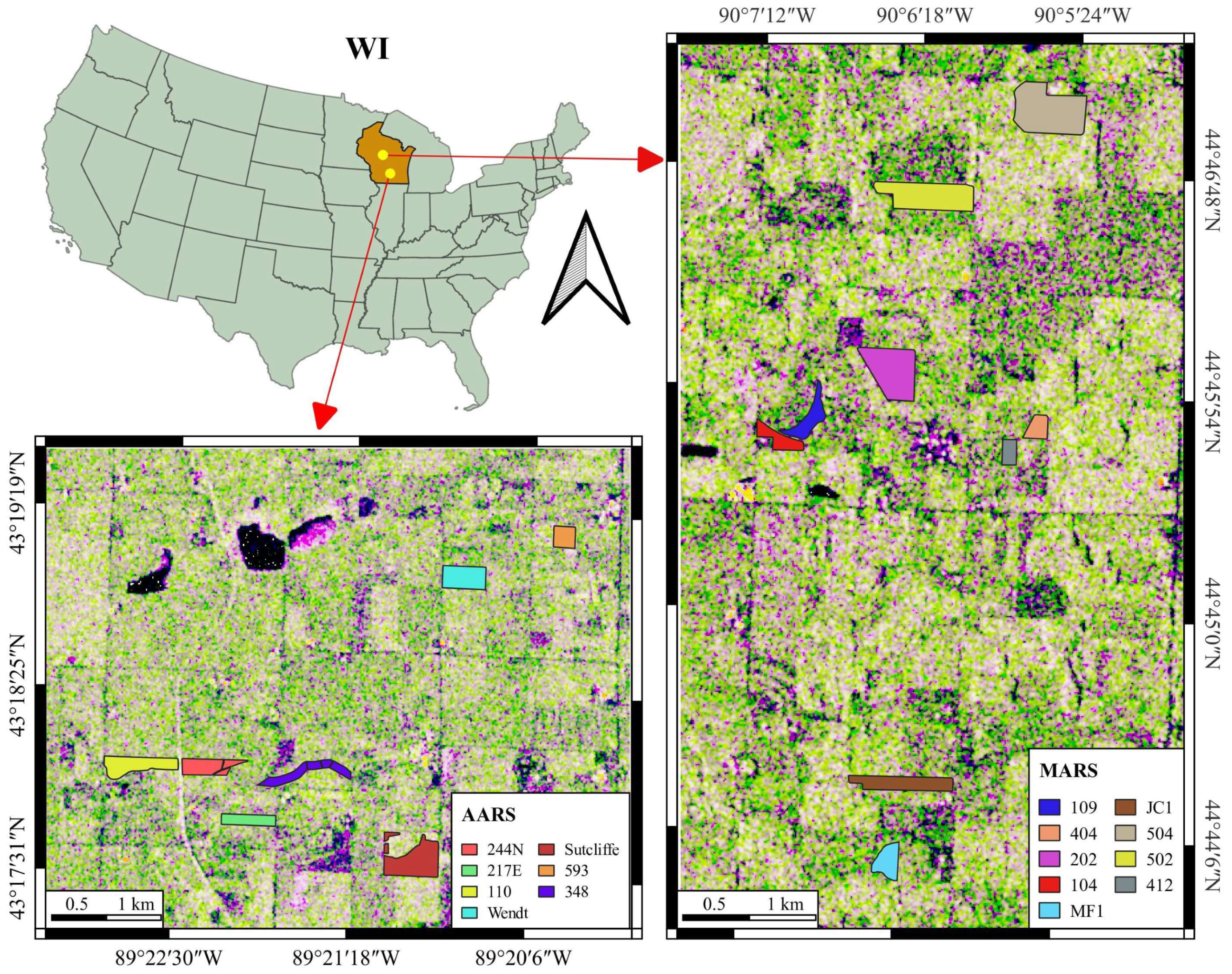
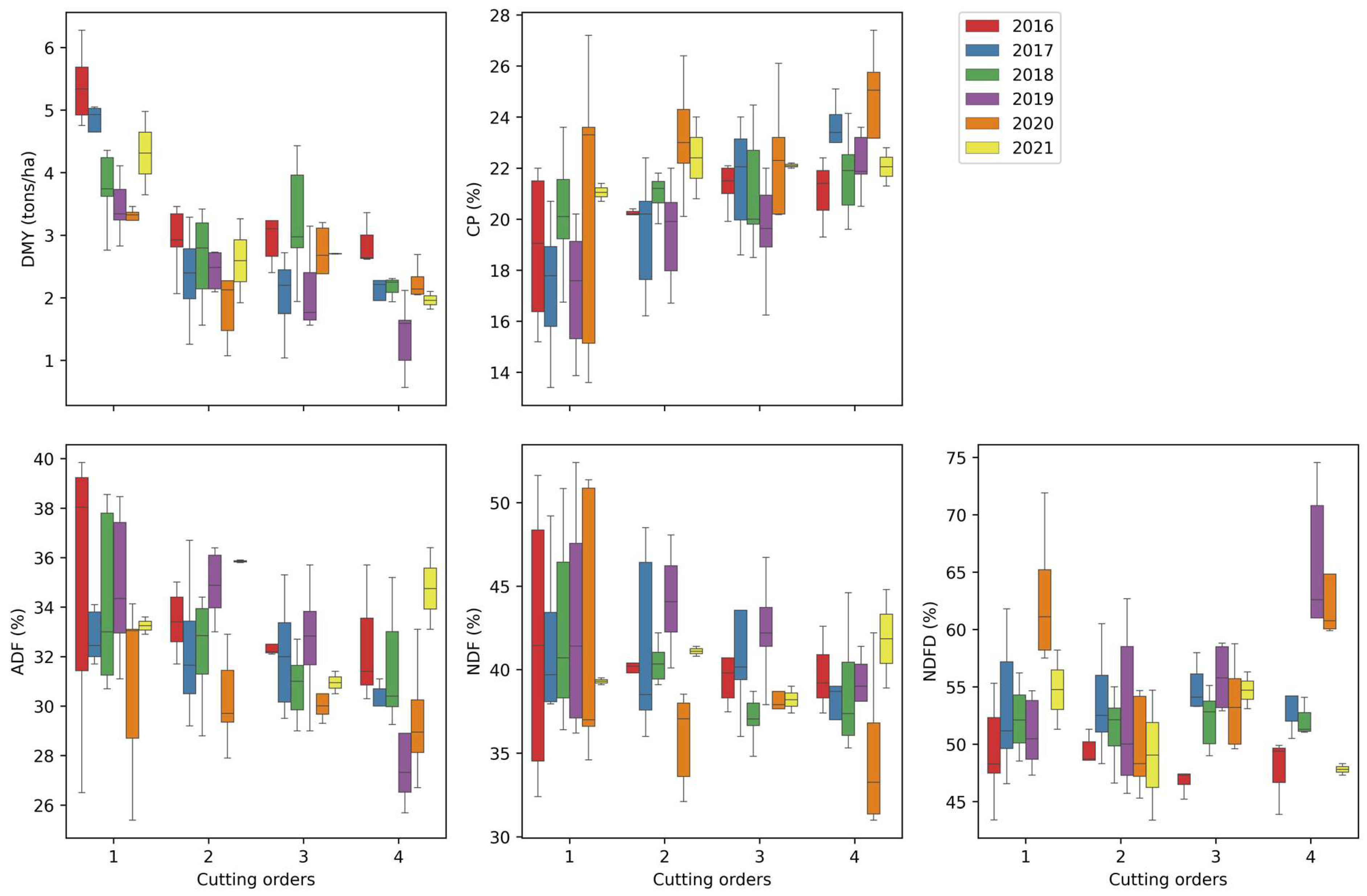

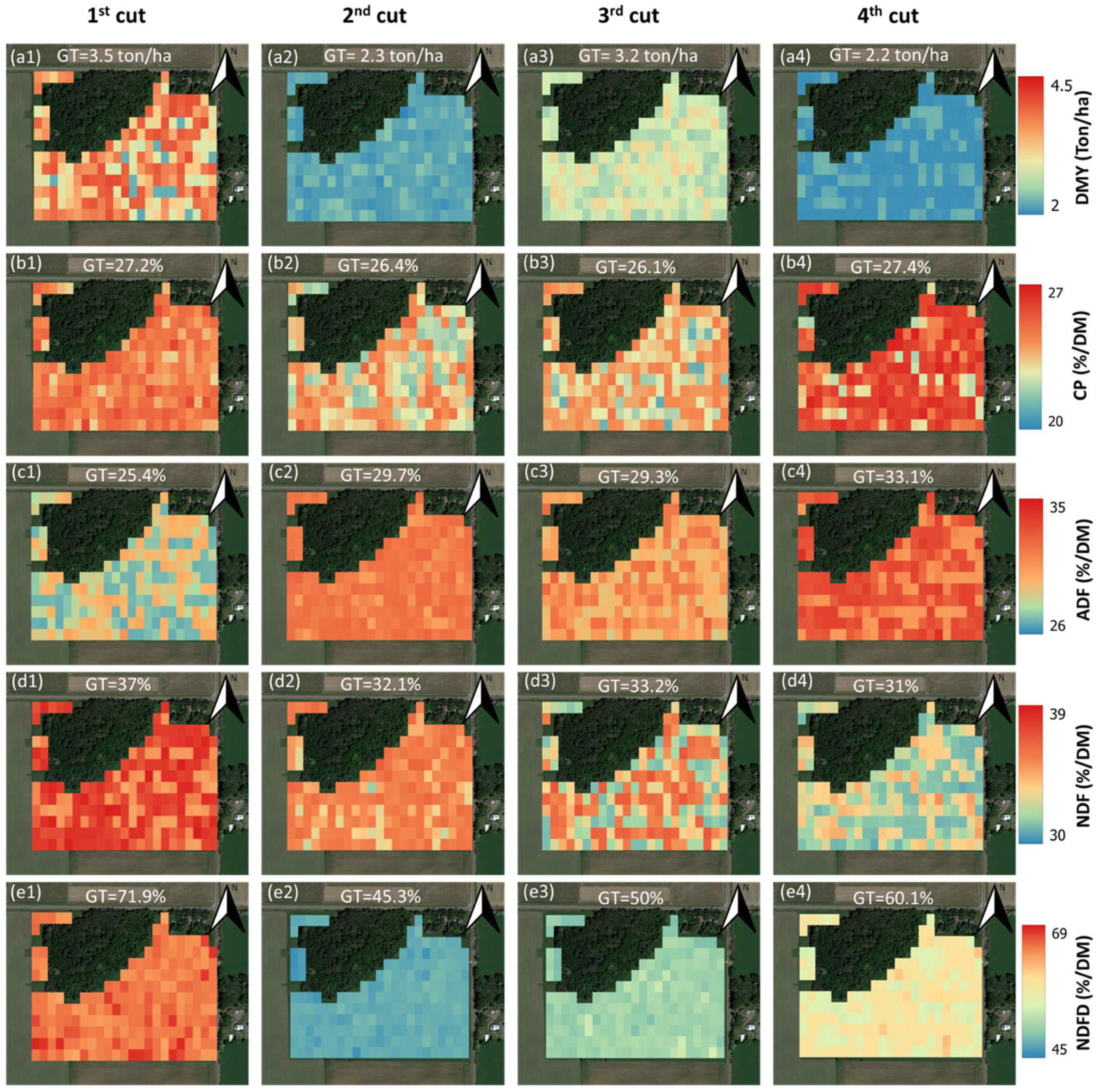
| Site ID | Year Seeded | Alfalfa Variety | Sampling Years |
|---|---|---|---|
| AARS-593 | 2013 | Pioneer 55V50 | 2016 (4), 2017 (4) |
| AARS-348 | 2014 | Mixed RR varieties | 2016 (4), 2017 (4), 2018 (4) |
| AARS-217E | 2015 | Pioneer 55V50/Dairyland HF3400 | 2016 (4), 2017 (4), 2018 (4) |
| AARS-244N | 2016 | HVXRR 4.0 Brand | 2017 (4), 2018 (4), 2019 (4) |
| AARS-Wendt | 2017 | Pioneer 55VR08 | 2018 (4), 2019 (4), 2020 (4) |
| AARS-110 | 2018 | Jung 4R418 | 2019 (4), 2020 (4), 2021 (4) |
| AARS-Sutcliffe | 2019 | HybriForce 3431 | 2020 (4), 2021 (4) |
| MARS-109 | 2014 | Dairyland Magnum 7/wet | 2016 (3), 2017 (4) |
| MARS-JC1 | 2015 | Dairyland Magnum 7/wet | 2016 (3), 2017 (3) |
| MARS-404 | 2016 | Dairyland Hybriforce 3405 | 2017 (3), 2018 (4) |
| MARS-504 | 2016 | Dairyland 2420/wet | 2017 (3), 2018 (4) |
| MARS-MF1 | 2017 | Dairyland 3420/wet | 2018 (4), 2019 (3) |
| MARS-202 | 2018 | Dairyland 3420/wet | 2019 (4), 2020 (4) |
| MARS-502 | 2018 | Dairyland 3420/wet | 2019 (4) |
| MARS-412 | 2016 | Pioneer 55V50 | 2016 (1) |
| MARS-104 | 2019 | Dairyland 3420/wet | 2020 (3) |
| Model | Hyperparameter | Searching Range |
|---|---|---|
| SVR | Squared L2 penalty | 0.01, 0.1, 0.5, 1, 5, 10, 100 |
| Gamma | 0.01, 0.1, 0.5, 1, 5, 10, 100 | |
| MLP | Activation | ‘identity’, ‘logistic’, ‘tanh’, ‘relu’ |
| Solver | ‘adam’, ‘sgd’ | |
| Hidden layers | 10, 15, 20, 25, 30, 35, 40 | |
| Batch size | 20, 24, 32, 40 | |
| Random state | 0, 1, 2, 3 | |
| RF | Max features | ‘sqrt’, ‘log2’, 0.3, 0.5, 1 |
| Number of trees | 30, 40, 50, 80, 100 | |
| The minimum samples at leaf | 2, 4, 6, 8, 10 | |
| Random state | 0, 1, 2, 3 | |
| XGB | Maximum depth | 3, 4, 5, 6, 7, 8 |
| Number of trees | 30, 40, 50, 80, 100 | |
| Learning rate | 0.01, 0.05, 0.1 | |
| Tree method | ‘exact’, ‘approx’, ‘hist’ | |
| L1 regularization | 0.4, 0.5, 0.8, 1 | |
| L2 regularization | 0.6, 0.8, 1, 1.2 |
| DMY | CP | ADF | NDF | NDFD | |
|---|---|---|---|---|---|
| Cutting orders | 30.78 *** | 6.35 *** | 14.93 *** | 10.97 *** | 11.67 *** |
| Daylight duration | 0.27 NS | 3.02 *** | 2.04 NS | 2.44 *** | 1.01 NS |
| Precipitation | 1.88 NS | 18.14 *** | 6.75 *** | 7.38 *** | 2.50 NS |
| Radiation | 0.68 NS | 0.98 NS | 1.06 NS | 0.39 NS | 0.02 NS |
| GDD | 3.86 NS | 6.99 *** | 1.15 NS | 3.57 NS | 6.73 *** |
| VP | 2.35 *** | 1.41 *** | 2.94 *** | 1.14 NS | 3.56 *** |
| Cutting orders: daylight duration | 1.88 NS | 5.71 *** | 2.62 NS | 2.62 NS | 3.39 NS |
| Cutting orders: precipitation | 1.28 NS | 1.45 *** | 7.04 *** | 2.73 *** | 3.38 *** |
| Cutting orders: radiation | 2.08 NS | 9.59 *** | 1.81 NS | 5.73 *** | 6.15 *** |
| Cutting orders: GDD | 0.28 NS | 1.16 NS | 3.24 *** | 1.19 NS | 1.58 NS |
| Cutting orders: VP | 2.97 NS | 11.69 *** | 2.25 NS | 4.81 *** | 4.98 *** |
| Error | 51.67 | 33.52 | 54.17 | 57.04 | 55.02 |
| DMY | CP | ADF | NDF | NDFD | |
|---|---|---|---|---|---|
| Cutting orders | 26.00 *** | 10.31 *** | 15.11 *** | 17.22 *** | 12.81 *** |
| Daylight | 0.79 NS | 1.96 * | 0.98 NS | 0.85 NS | 1.05 NS |
| Precipitation | 0.94 NS | 2.12 * | 0.78 NS | 0.36 NS | 0.04 NS |
| Radiation | 2.18 * | 0.54 NS | 0.84 NS | 0.39 NS | 1.04 NS |
| GDD | 1.91 * | 1.70 NS | 4.64 * | 1.86 NS | 3.18 *** |
| VP | 0.83 NS | 1.64 NS | 2.51 NS | 0.56 NS | 2.27 NS |
| Cutting orders: daylight | 2.89 NS | 14.23 *** | 4.67 NS | 4.99 NS | 2.46 NS |
| Cutting orders: precipitation | 3.73 NS | 5.21 * | 1.36 NS | 3.11 NS | 5.07 NS |
| Cutting orders: radiation | 2.91 NS | 4.96 * | 2.08 NS | 3.08 NS | 1.05 NS |
| Cutting orders: GDD | 1.59 NS | 6.79 ** | 1.44 NS | 3.97 NS | 7.27 *** |
| Cutting orders: VP | 2.53 NS | 8.61 ** | 1.42 NS | 2.83 NS | 4.50 NS |
| Gaps | 0.04 NS | 0.05 NS | 0.15 NS | 0.44 NS | 0.50 NS |
| VV | 3.43 *** | 0.02 NS | 0.28 NS | 0.10 NS | 0.02 NS |
| VH | 3.44 *** | 0.02 NS | 0.28 NS | 0.10 NS | 0.02 NS |
| CR | 1.20 NS | 0.07 NS | 1.20 NS | 0.13 NS | 3.40 *** |
| DPSVIm | 0.22 NS | 0.00 NS | 0.04 NS | 0.34 NS | 0.11 NS |
| Pol | 0.08 NS | 0.53 NS | 0.01 NS | 0.25 NS | 0.18 NS |
| RVIm | 0.26 NS | 0.00 NS | 0.06 NS | 0.30 NS | 0.14 NS |
| VH-VV | 3.44 *** | 0.02 NS | 0.28 NS | 0.10 NS | 0.02 NS |
| Cutting orders: VV | 1.40 NS | 1.45 NS | 1.79 NS | 1.80 NS | 0.10 NS |
| Cutting orders: VH | 1.39 NS | 1.45 NS | 1.80 NS | 1.80 NS | 0.10 NS |
| Cutting orders: CR | 0.43 NS | 0.42 NS | 0.63 NS | 1.57 NS | 0.43 NS |
| Cutting orders: DPSVIm | 0.28 NS | 0.37 NS | 3.20 NS | 1.39 NS | 0.57 NS |
| Cutting orders: Pol | 3.06 NS | 0.77 NS | 0.49 NS | 2.96 NS | 1.69 NS |
| Cutting orders: RVIm | 0.31 NS | 0.37 NS | 3.23 NS | 1.43 NS | 0.58 NS |
| Cutting orders: VH-VV | 1.39 NS | 1.45 NS | 1.80 NS | 1.80 NS | 0.10 NS |
| Error | 33.32 | 34.96 | 48.95 | 46.26 | 51.33 |
| Input | Traits | SVR | MLP | RF | XGB | LR | ||||||||||
|---|---|---|---|---|---|---|---|---|---|---|---|---|---|---|---|---|
| R2 | RMSE | MAE | R2 | RMSE | MAE | R2 | RMSE | MAE | R2 | RMSE | MAE | R2 | RMSE | MAE | ||
| Group 1 | DMY | 0.51 | 0.82 | 0.64 | 0.46 | 0.84 | 0.69 | 0.41 | 0.89 | 0.72 | 0.28 | 0.99 | 0.77 | 0.34 | 0.94 | 0.77 |
| CP | 0.39 | 2.28 | 1.70 | 0.20 | 2.61 | 1.91 | 0.42 | 2.22 | 1.68 | 0.39 | 2.29 | 1.75 | 0.20 | 2.61 | 1.97 | |
| ADF | 0.25 | 2.92 | 2.13 | 0.15 | 3.10 | 2.27 | 0.19 | 3.04 | 2.31 | −0.01 | 3.38 | 2.53 | 0.19 | 3.03 | 2.25 | |
| NDF | 0.35 | 4.48 | 3.14 | 0.21 | 4.91 | 3.51 | 0.32 | 4.57 | 3.23 | 0.20 | 4.94 | 3.51 | 0.13 | 5.16 | 3.75 | |
| NDFD | 0.21 | 5.60 | 4.16 | 0.06 | 6.08 | 4.57 | 0.17 | 5.72 | 4.29 | 0.18 | 5.68 | 4.27 | 0.10 | 5.97 | 4.70 | |
| Group 2 | DMY | 0.40 | 0.89 | 0.72 | 0.43 | 0.89 | 0.72 | 0.42 | 0.89 | 0.72 | 0.33 | 0.94 | 0.74 | 0.37 | 0.91 | 0.77 |
| CP | 0.24 | 2.55 | 1.90 | 0.23 | 2.57 | 1.93 | 0.21 | 2.60 | 1.95 | 0.06 | 2.84 | 2.18 | 0.16 | 2.67 | 2.01 | |
| ADF | 0.12 | 3.15 | 2.39 | 0.11 | 3.17 | 2.40 | 0.08 | 3.23 | 2.41 | −0.08 | 3.49 | 2.63 | 0.02 | 3.33 | 2.54 | |
| NDF | −0.01 | 5.58 | 3.90 | −0.04 | 5.65 | 3.94 | 0.05 | 5.41 | 4.01 | −0.27 | 6.23 | 4.52 | −0.08 | 5.75 | 4.31 | |
| NDFD | 0.07 | 6.06 | 4.53 | 0.11 | 5.95 | 4.52 | 0.17 | 5.73 | 4.21 | 0.10 | 5.98 | 4.41 | 0.02 | 6.22 | 4.70 | |
| Group 3 | DMY | 0.50 | 0.82 | 0.64 | 0.43 | 0.89 | 0.72 | 0.40 | 0.89 | 0.69 | 0.32 | 0.96 | 0.74 | 0.36 | 0.91 | 0.77 |
| CP | 0.29 | 2.46 | 1.73 | 0.28 | 2.48 | 1.85 | 0.40 | 2.26 | 1.71 | 0.27 | 2.49 | 1.90 | 0.21 | 2.59 | 2.00 | |
| ADF | 0.19 | 3.02 | 2.16 | 0.20 | 3.00 | 2.22 | 0.19 | 3.02 | 2.24 | 0.08 | 3.23 | 2.36 | 0.18 | 3.05 | 2.31 | |
| NDF | 0.21 | 4.92 | 3.47 | 0.17 | 5.04 | 3.60 | 0.33 | 4.52 | 3.25 | 0.27 | 4.73 | 3.44 | −0.01 | 5.56 | 4.02 | |
| NDFD | 0.15 | 5.79 | 4.16 | 0.24 | 5.48 | 4.16 | 0.18 | 5.71 | 4.15 | 0.16 | 5.76 | 4.25 | 0.18 | 5.69 | 4.41 | |
Disclaimer/Publisher’s Note: The statements, opinions and data contained in all publications are solely those of the individual author(s) and contributor(s) and not of MDPI and/or the editor(s). MDPI and/or the editor(s) disclaim responsibility for any injury to people or property resulting from any ideas, methods, instructions or products referred to in the content. |
© 2024 by the authors. Licensee MDPI, Basel, Switzerland. This article is an open access article distributed under the terms and conditions of the Creative Commons Attribution (CC BY) license (https://creativecommons.org/licenses/by/4.0/).
Share and Cite
Yu, T.; Zhou, J.; Ranjbar, S.; Chen, J.; Digman, M.F.; Zhang, Z. Evaluation of the Effect of Sentinel-1 SAR and Environmental Factors in Alfalfa Yield and Quality Estimation. Agronomy 2024, 14, 859. https://doi.org/10.3390/agronomy14040859
Yu T, Zhou J, Ranjbar S, Chen J, Digman MF, Zhang Z. Evaluation of the Effect of Sentinel-1 SAR and Environmental Factors in Alfalfa Yield and Quality Estimation. Agronomy. 2024; 14(4):859. https://doi.org/10.3390/agronomy14040859
Chicago/Turabian StyleYu, Tong, Jing Zhou, Sadegh Ranjbar, Jiang Chen, Matthew F. Digman, and Zhou Zhang. 2024. "Evaluation of the Effect of Sentinel-1 SAR and Environmental Factors in Alfalfa Yield and Quality Estimation" Agronomy 14, no. 4: 859. https://doi.org/10.3390/agronomy14040859
APA StyleYu, T., Zhou, J., Ranjbar, S., Chen, J., Digman, M. F., & Zhang, Z. (2024). Evaluation of the Effect of Sentinel-1 SAR and Environmental Factors in Alfalfa Yield and Quality Estimation. Agronomy, 14(4), 859. https://doi.org/10.3390/agronomy14040859








